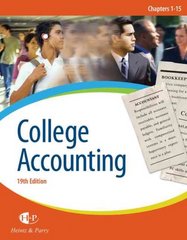Question
Problem 1; The Components Division produces a part that is used by the Goods Division.The cost of manufacturing the part is given below; Direct Materials................................10.00
Problem 1;
The Components Division produces a part that is used by the Goods Division.The cost of manufacturing the part is given below;
Direct Materials................................10.00
Direct labor..................................... 2.00
Variable overhead.............................3.00
Fixed Factory overhead(based on a practical
volume of 200,000 parts)............5.00
20.00
=====
Other costs incurred by the Components Division are as follows;
Fixed selling and administrative expensesP500,000
Variable SellingP1 per unit
The part usually sells for between P28 and P30 in the external market.Currently, the Components Division is selling it to external customers for P29.The division is capable of producing 200,000 units of the part per year; however, because of a weak economy, only 150,000 parts are expected to be sold during the coming year.The variable selling expenses are avoidable if the part is sold internally.
The Goods Division has been buying the same parts from an external supplier for P28.It expects to use 50,000 units of the part during the coming year.The manager of the Goods Division has offered to by 50,000 units from the Components Division for P18 per unit.
1.What would the minimum transfer price that the Components Division would accept? ________________________
2.What would be the maximum transfer price that the manager of the Goods Division would pay?_______________________
3.Should an internal transfer take place? _________________
4.If your were the manager of the Component Division, would you sell the 50,000 units for P18 each? Why? (Show your proof with proper computation to support your decision).
5.Suppose that the average operating assets of the Components Division total P10 million.Compute the ROI for the coming year, assuming that the 50,000 units are transferred to the Goods Division for P21 each.
Problem 2;
Melrose Company has a decentralized organization with a divisional structure.Each divisional manager is evaluated on the basis of ROI.The Plastic Division produces a plastic container that the chemical division can use.Plastics can produce up to 100,000 of these containers per year.The variable costs of manufacturing the plastic containers are P4.The Chemical Division labels the plastic containers and uses them to store an important industrial chemical, which is sold to outside customers for P50 per container.The division's capacity is 20,000 units.The variable costs of processing the chemical (in addition to the cost of the container itself) are P26.
1.Assume that all of the plastic containers produced can be sold to external customers for P10 each.The Chemical Division wants to buy 20,000 containers per year.What should be the transfer price? _________________
2.Assume that the Plastics Division is operating at 75% capacity.The chemical Division is currently buying 20,000 containers from an outside supplier for P7.50 each.Assume that any joint benefit will be split evenly between the two divisions.
a.What is the expected transfer price? _________________
b.How much will the profits of the whole firm increase under this arrangement?___________________
c.How much will the profits of the Plastic Division increase, assuming that it sells the extra 20,000 containers internally? _____________
Problem 3;
Derek Products, Inc. has a North Division that manufactures and sells a standard valve as follows;
Capacity in units100,000
Selling price to outside customers on marketP30
Variable cost per unit16
Fixed costs per unit (based on capacity)9
The company has a South division that could use this valve in the manufacture of one of its pumps.The south division is currently purchasing 10,000 valves per year from an overseas supplier at a cost of P29 per valve.
1.Assume that the North Division has ample idle capacity to handle all of the South Division's needs.What should be the transfer price between the two Divisions?_______________________
2.Assume that the North Division is selling all that it can produce to outside customers on the intermediate market.What should be the transfer price between the divisions?__________________ At this price, will any transfers be made? __________Why? _______________________________________
3.Assume again that the North Division is selling all that it can produce to outside customers on the intermediate market.Also assume that P3 in variable expenses on intracompany sales, due to reduced selling costs.What should be the transfer price between the two divisions? ______________________
4.Refer to the original data given above, assume that the South Division needs 20,000 special valves per year that are to be supplied by the North Division.The North Division's variable costs to manufacture and ship the special valve would be P20 per unit.To produce these special valves, the North Division would have to give up one half of its production of the regular valves (that is cut its production of the regular valves from 100,000 units per year to 50,000 units per year.You can assume that the North Division is selling all of the regular valves that it can produce to outside customers on the intermediate market.If the North Division decides to produce the special valves for the South Division, what transfer price should it charge per valve? ____________
Step by Step Solution
There are 3 Steps involved in it
Step: 1

Get Instant Access to Expert-Tailored Solutions
See step-by-step solutions with expert insights and AI powered tools for academic success
Step: 2

Step: 3

Ace Your Homework with AI
Get the answers you need in no time with our AI-driven, step-by-step assistance
Get Started


